Antibody data
- Antibody Data
- Antigen structure
- References [1]
- Comments [0]
- Validations
- Immunocytochemistry [2]
- Immunohistochemistry [2]
- Other assay [3]
Submit
Validation data
Reference
Comment
Report error
- Product number
- PA5-58478 - Provider product page

- Provider
- Invitrogen Antibodies
- Product name
- METTL7B Polyclonal Antibody
- Antibody type
- Polyclonal
- Antigen
- Recombinant protein fragment
- Description
- Immunogen sequence: RVLRPGGVLF FWEHVAEPYG SWAFMWQQVF EPTWKHIGDG CCLTRETWKD LENAQFSEIQ MERQPPPLKW LPVGPHIMGK AV Highest antigen sequence identity to the following orthologs: Mouse - 83%, Rat - 80%.
- Reactivity
- Human
- Host
- Rabbit
- Isotype
- IgG
- Vial size
- 100 μL
- Concentration
- 0.2 mg/mL
- Storage
- Store at 4°C short term. For long term storage, store at -20°C, avoiding freeze/thaw cycles.
Submitted references Human METTL7B is an alkyl thiol methyltransferase that metabolizes hydrogen sulfide and captopril.
Maldonato BJ, Russell DA, Totah RA
Scientific reports 2021 Mar 1;11(1):4857
Scientific reports 2021 Mar 1;11(1):4857
No comments: Submit comment
Supportive validation
- Submitted by
- Invitrogen Antibodies (provider)
- Main image
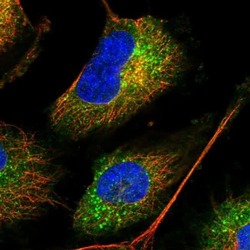
- Experimental details
- Immunofluorescent staining of METTL7B in human cell line U-251 MG shows positivity in vesicles & microtubules. Samples were probed using a METTL7B Polyclonal Antibody (Product # PA5-58478).
- Submitted by
- Invitrogen Antibodies (provider)
- Main image
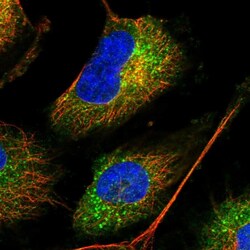
- Experimental details
- Immunofluorecent analysis of METTL7B in human cell line U-251 MG using METTL7B Polyclonal Antibody (Product # PA5-58478). Staining shows localization to microtubules and vesicles.
Supportive validation
- Submitted by
- Invitrogen Antibodies (provider)
- Main image
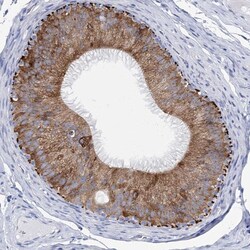
- Experimental details
- Immunohistochemical staining of METTL7B in human epididymis using METTL7B Polyclonal Antibody (Product # PA5-58478) shows high expression.
- Submitted by
- Invitrogen Antibodies (provider)
- Main image
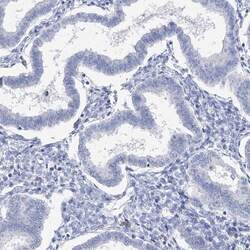
- Experimental details
- Immunohistochemical staining of METTL7B in human endometrium using METTL7B Polyclonal Antibody (Product # PA5-58478) shows low expression as expected.
Supportive validation
- Submitted by
- Invitrogen Antibodies (provider)
- Main image

- Experimental details
- Figure 2 Overexpression of the METTL7B gene in HeLa cells: ( A ) RT-PCR data measuring METTL7B gene expression in HeLa cells treated with a METTL7B overexpression plasmid compared to control cells transfected with an empty expression vector. ( B ) S -methyl captopril measured 24 h following the addition of captopril (500 uM) to HeLa cells treated with METTL7B overexpression plasmid compared to control cells. ( C ) FLAG-tagged METTL7B expression is only observed in HeLa cells treated with the METTL7B overexpression plasmid and not in controls. Western blot using an anti-FLAG antibody confirmed the expression of METTL7B in HeLa cells. Full gel images are available in Supplementary Fig. 1 . All data is presented as the mean +- s.d. Individual data points are plotted from two separate experiments. Significance was determined using unpaired two-tailed t test. **** P < 0.0001.
- Submitted by
- Invitrogen Antibodies (provider)
- Main image
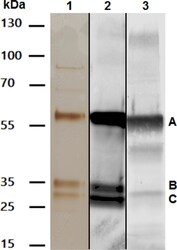
- Experimental details
- Figure 3 Purified His-GST-METTL7B: (Lane 1) SDS-PAGE silver stain of a representative gel showing purified His-GST-METTL7B (A). Gel lanes were loaded with a 1 µg total protein as determined by A 280. (Lane 2) Anti-GST antibody western blot of purified His-GST-METTL7B (1 µg total protein). (Lane 3) Western blot using anti-METTL7B antibody of purified His-GST-METTL7B (A) using 0.1 µg total protein. Molecular weight markers are shown to the left. The lower molecular bands, marked by letters B and C, are fusion protein fragments containing the dual His-GST affinity tag.
- Submitted by
- Invitrogen Antibodies (provider)
- Main image
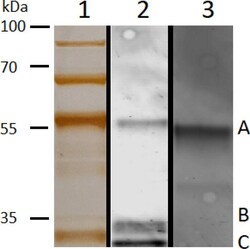
- Experimental details
- Figure 4 SDS-PAGE and western blot analysis of purified His-GST-METTL7B-D98A: (Lane 1) SDS-PAGE silver stain of a representative gel showing purified His-GST-METTL7B-D98A (A) (4.2 µg total protein) (Lane 2) Anti-GST antibody western blot of purified His-GST-METTL7B-D98A (3 µg total protein). (Lane 3) Anti-METTL7B antibody western blot of purified His-GST-METTL7B-D98A (4.3 µg total protein). Molecular weight markers are shown to the left. Upper bands, above 55 kDa, are co-purifying chaperone proteins as determined by proteomic analysis (data not shown). Lower molecular bands, marked by letters B and C, are fusion protein fragments containing the dual His-GST affinity tag.
 Explore
Explore Validate
Validate Learn
Learn Western blot
Western blot Immunocytochemistry
Immunocytochemistry